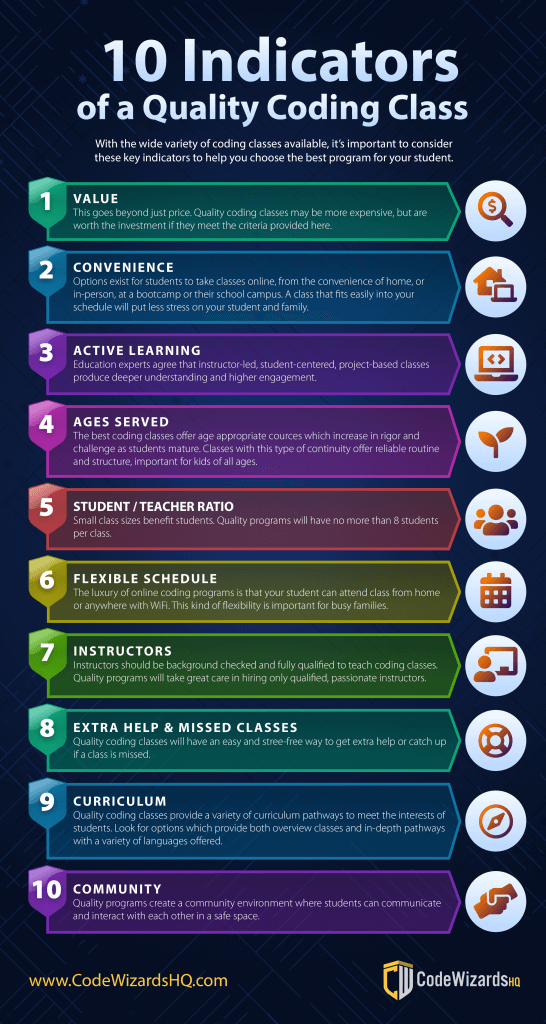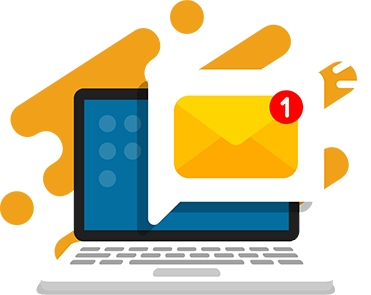Learning to code has become as popular as the top national sports and with good reason!
Recently, coding has gone from being a cool after school activity to becoming part of educational legislation. To us, it’s obvious why kids should learn to code. 33 states have passed bills in the last five years to officially offer programming in the school curriculum. Coding classes for kids have been integrated into traditional courses and many states are offering math and foreign language credit for taking programming classes.
Coding is a foundational tool critical for student success in the 21st Century.
Coding classes are popping up left and right, and the challenge of finding the right coding class for your kid has become increasingly difficult. Variety is the spice of life but making choices and evaluating coding programs can be really complicated!

How to Evaluate Coding Classes for Your Kid
Here are some of the major considerations when choosing the best coding class for your student.
Value:
Let’s start with an important aspect of any activity – PRICE. Parents have to consider budget. Coding classes can range from free to hundreds of dollars a month. Continuous learning is the best way for kids to actually “learn” the material so making sure they have access to a platform on which they can practice their skills at any time is vital.
Convenience:
No one wants to make a long commute in order to get students to an activity. Are you willing to drive your student to classes and how far? Are you including the time spent in traffic to your evaluation? Or do you prefer an online course or one at your child’s school? Can you travel while your child is in the course?
Active Learning
The teaching method and style offered in top coding schools gravitate toward student-centered, active learning. Coding games for kids are popular and nothing beats being able to write code yourself. Active learning engages students more fully in the content and leads to a deeper and fuller understanding. Quality programs will offer students opportunities to present projects and practice skills with minimal lecture.
“The meta-analysis, published online today in the Proceedings of the National Academy of Sciences, concluded that teaching approaches that turned students into active participants rather than passive listeners reduced failure rates and boosted scores on exams by almost one-half a standard deviation.” – Aleszu BajakMay from Science.com
Ages Served:
The best coding classes offer age-appropriate courses which increase in rigor and challenge as students mature. Classes with this type of continuity offer reliable routine and structure, important for kids of all ages.
“Structure and routines teach kids how to constructively manage themselves and their environments.”- Aha Parenting
Student/Teacher Ratio:
Class sizes can have an immense impact on learning. Thus, it is an important consideration when considering a coding class. Quality coding classes offer small class sizes so that individual student needs can be met.
Flexible Schedule:
A key consideration in choosing a coding program is how the schedule and format fit into the family calendar. Quality coding classes will offer a variety of class durations and options to catch up via self-paced components or recorded review of classes if a session is missed. They should also have a solid teaching methodology that is published and followed by all teachers. Parents should see clear evidence of a well thought out pedagogy. Quality coding classes will gladly provide this information in detail.
- How is content delivered?
- How does content change depending on age?
- Are classes teacher-centered, student-centered, or a mix of both?
- How are teachers trained?
- How are students evaluated?
- How do teachers communicate with parents? (this may be a little out of the scope but still a very worthwhile question!)
Teachers:
Quality coding classes should require a full background check on all teachers, just as any school is required to do. Any adult interacting with students, whether online or in-person, should go through a full background check. A good coding school will also vet every teacher to be sure every teacher has the experience, knowledge, and enthusiasm necessary for a positive student experience. Your child’s safety and quality interaction are key when choosing a coding class.
Extra Help & Missed Classes:
Children learn at different paces and it is important that they have help available when needed. A quality coding class will offer additional help for students who are struggling or have missed a class and need to catch up. Additional help should be easy to schedule at convenient times for the student.
The Curriculum:
Quality coding classes will offer paths for students to gain an overview of several languages and technologies, as well as the opportunity to focus on particular areas of interest. Students and parents should discuss which kinds of programs are the best fit. For instance, do your students want to learn about a theme? Or do you want the knowledge to be foundational and grow in a sequential way that can provide a well-rounded skill set? To illustrate the concept, let’s use a travel example. Before a trip to Europe, you might sign up for classes that teach basic phrases in several languages like ¡Hola! ¿Dónde está el baño? – Hello! Where is the bathroom? You would also study these same basic phrases in French or other languages that fit your itinerary. This would be “theme” based learning. Perhaps you decide you want to spend more time in France and want to learn the language in-depth. After in-depth study and practice, you will be able to speak fluent French to help make your trips to France more enjoyable. This idea is the same in coding; students can learn the basics of an “area” or can take a series of courses that can in time provide the ability for complex thoughts to be communicated.
Community:
Quality programs create a community environment where students can communicate and interact with each other in a safe space. This sense of community can be a great support system and network for students struggling to learn difficult coding concepts. In addition, they can ask each other questions and even make new friends.
Prepare your child for success: If you are looking for your child to learn to code, explore our live, instructor-led coding classes. Thousands of satisfied students. Highly rated. [Find Out More]
What should I look for in a coding class for my kid?
We have asked some experts and #TechEduambassadors their opinion about how to choose the right coding class for your kid. These are their answers.
“The terms of service. While corporate apps need to monetize, tools like Scratch (built by teachers for teachers) respect student data and privacy.”
– Brian Aspinall
Brian is a globe-trekking educator on a mission to expose as many kids to Computer Science as possible. He is the author of @codebreakeredu, @blockbreakeredu, has given TEDx Talks, & received the prestigious Canadian Prime Minister’s Award. Follow him @mraspinall!
“There are so many coding programs available for kids that it’s hard to choose the right one. I’ve reviewed hundreds of programs over the years with very mixed results. The problem with evaluating programs is that very few parents have the technical and/or educational background to find the good ones. Good programs effectively teach the content. That means the program creators have a firm grasp on both pedagogical (how to teach kids) best practices and ability-appropriate content.
The first thing I do when I evaluate a program is head over to the “Our Team” page on their website. I look for a strong educator and content expert on the team. Most programs lack an expert educator, believing that expert programmers are all that’s needed. If I don’t see an educator with classroom experience on the team, that’s a huge red flag, yet I see it all the time.
Next, I look at what the kids will be doing in the program. I look for programs that balance providing content knowledge with open creativity. Many programs are too structured, leaving no room for creativity. If every kid’s project looks the same at the end of a lesson, that’s a problem. Kids learn coding best when they are able to express themselves through relevant projects. Kids should have a choice and be able to express their voice.
Lastly, I look at the programming environment itself. I look for age-appropriateness. Recent research has shown the benefits kids enjoy when they start their journey into coding using a visual block-based programming language. I look for block-based coding for elementary and younger. For middle school and above block-based isn’t a requirement, but it’s nice to see if they have a transitional option to start with block-based and move to a text-based language as they grow. I’ve noticed that most teams with an experienced educator choose appropriate coding environments because they understand the importance of scaffolding and meeting kids in their Zone of Proximal Development (ZPD). For middle school and younger, I couldn’t care less about “real-world professional programming languages,” don’t get caught in that trap.”
– Grant Smith
Grant is an educator fascinated by the challenge of teaching children computer science. Currently, he’s the Director of Education for codeSpark, a company focused on teaching elementary kids how to code. When he’s not teaching, he’s writing. He’s the author of Everything You Need to Ace Coding and Computer Science in One Big Fat Notebook. He has also written multiple coding curricula. For more information, visit Grant at http://wgrantsmith.com or on Twitter @wgrantsmith.
“I think it is always important to figure out what the purpose is when using any tech, or teaching something like coding. There, of course, are concerns about access and that has to be the first consideration is making sure students have access, the resource is something that will benefit students beyond short term and that will help them to develop a variety of skills.
I like trying to find resources that parents can also use to work with/learn with students at home as well. I try to focus on how it can be used, beyond for a computer science course, or STEAM, how can we apply it beyond certain content areas and grade levels.”
– Rachelle Dene Poth
Rachelle is a French, Spanish and STEAM Teacher. She also works as an EdTech Consultant, through THRIVEinEDU LLC. You can follow her on Twitter or visit her website. She is the author of “In Other Words” and “The Future is Now” bit.ly/Pothbooks.
As students move from being content consumers to content creators, the CodeWizardsHQ program prepares them to create AR & VR of the future.”
– Jamie Donally
Jaime Donally is a passionate technology enthusiast. She began her career as a math teacher and later moved into Instructional Technology. Follow her on Twitter or visit her website.
“When looking at programs, look for the benefits after the program. Skillset and knowledge that will be gained. An experience that can be useful when applying for colleges and jobs. You will then see the value in the money or time spent, building for the future.”
– Brandie Ann Meister
Brandie is the director of ChickTech-Austin an organization that engages women & girls of all ages in the tech industry while working to create a better tech culture for all. Learn more at https://chicktech.org/
“Before selecting a coding program I think that parents should ask themselves two questions. One, will my child be challenged by the material? And two, will my child be engaged by the material? Finding the perfect balance between what a student will be challenged by and what the student will enjoy, will ensure that students feel they are making good use of their time and that parents are making good use of their money.”
– Elizabeth Rodriguez
Elizabeth is the Executive Director of SoHacks. The largest Hackathon of the South.
“As a parent, you want to encourage your kids to be curious, creative, and seek joy when learning. When learning a programming language, I would advise to start with the end result goal, maybe building a game or a fun tool, and then working backward to build it. That also gives the opportunity to build the same game/tool with a few different programming languages to see their advantages & disadvantages.”
– Domingo Guerra
Domingo is a Mexican Entrepreneur that took Silicon Valley by storm with Appthority a mobile security company, co-founded and later sold to Symantec. Follow him on Twitter.
“The instructor and his/her ability to connect with the students.”
– Chris Butler
Chris is the CEO of URAllowance, he is focused on education and preparing our youth for tomorrow. Follow him on Twitter.
- That it fits in their schedule (not taking up too much time each lesson) broken down into short components.
- That the lessons are easily understood by the student and do not need extensive help from the teacher. (Independent work preferred).
- That the coding program transfers over to a future career benefit/opportunity.
- If for higher education, there is a guide or understanding of how many credits the completion of the course would give on a transcript.
- The coding program uses up to date technology and/or languages
– Deborah Wuehler
Deborah is the Senior Editor, Director of Production at The Old Schoolhouse Magazine, the trade magazine and a top resource in home education since 2001! Follow them on Twitter.
I would advise parents to look at how a program is going to engage and involve the kids. Every student is different, and every student learns differently, so I would hope to see programs that have a variety of educational techniques from hands-on learning to experimental and your classic lecturing, but I don’t think a program should focus solely on one technique. Additionally, I think it depends on the age of the student, but you want to make sure the program is going to be “fun” and allow students to use their creativity as they learn. “
– Christina Cardoza
Christina is an experienced technology and software development reporter and currently the Senior Editor for SDTimes. Follow her on Twitter.
“Coding, in my opinion, is best taught as a means to an end. Find out what your child is interested in and what programs they need to learn to accomplish a task. Also, I’m not sure there are very many “programs” that would fit your definition that are available on the open market for parents to engage with. Most are out-of-school programs that have week-long sessions or that meet once a month for a school year. I don’t know of any bootcamps that are open to K12 students.
The cool thing about coding is that it can be learned in all different kinds of ways, depending on how the child learns best. Start with some block-based programming at younger ages to teach computational thinking. Don’t invest heavily in really expensive toys…you can get a micro: bit for $18 and it’s just as engaging and can teach even more than a $100+ robot. Once you know your child likes coding and wants to learn more, point him or her to a free online platform. Do they like game design? Try Alice. Do they want to develop a mobile app? Introduce the child to AppLab or MIT App Inventor. Are they older and want a deep dive into coding? Start with Khan Academy, Codecademy or EdX and move to university Open Courseware…like MIT, Yale or Harvard. Is there an interest in cybersecurity? Maybe work towards a CompTIA certification. “
– Debi Pfitzenmaier
Debi is the founder of Youth Code Jam in San Antonio, TX. Follow her on Twitter.
“I would look for a program that emphasizes creating algorithms and solving problems. I would not focus on the particular programming languages that are used in the program.
I would also look for a program allows students to pick the problems they solve. Not necessarily all the time, but at least some of the time.”
– Mike Scott
Mike is a Professor of Instruction at the University of Texas at Austin in the Computer Science Department. Visit his website.
“A hallmark to a good coding curriculum for youth and young adults is gamification. Engaging young people in coding requires their excitement – gamification and fun built-in really drives youth to go further and try more. They want to achieve that next level or rank. Along the way, they should be able to tie the work they are doing to a problem they are solving.”
– Scott Luikart
Scott is a Salesforce MVP, Golden Hoodie Dreamforce 2017, and he is currently Salesforce Admin at Whole Foods Market. Follow him on Twitter.
“First, they need to consider what language the camp is based on. Scratch and other simple languages are great for younger kids or children who like the bright colours and ease of use, but more “advanced” languages, such as Python, Go, or Java, leave more doors open for innovation and expression and are used in business environments where fluency and understanding can really make a difference.
The second is how big the class is. Is the class packed like sardines in a tin? If so, the kids might not be able to get all their questions answered, unless there are plenty of teachers to keep up. Worse yet, an overcrowded class could mean a physically cramped and uncomfortable workspace, especially if the activities include a moving bot. On the other hand, however, an empty class might mean the student misses out on the “summer camp buzz.” Also, there are fewer children to form a group with, which can be a problem because working in groups is conducive to learning and sharing and is what provides the social aspect that is a large part of the purpose of this kind of camp in the first place. Thirdly, one has to take a look at the teachers. Do they have any real-world experience with coding, especially in the language they’re teaching? Have at least some of them run similar camps before, or perhaps even have actual educational experience? For any kind of camp for children, safety should always be considered, as well. While it’s not nice to think about, are the teachers and staff suitable to take care of children on their own? Will there be someone who is CPR-certified or has first-aid credentials? Is the location relatively secure and will a security officer of some kind be present? Another consideration is whether the camp is age-appropriate. What’s fun and engaging for a seven-year-old might be dull and repetitive for a twelve-year-old and completely disorienting and frustrating for a three-year-old. Visual editors, like Scratch, can be perfect for younger kids because there’s no worrying over typos or a missed colon, not to mention the bright colors and ability to hit “Run” at any time. On the other hand, kids with a solid grasp on spelling and formatting might find text-based IDEs to be more challenging and more engaging, especially since they have more options for creativity and more areas to explore, and also provide the knowledge that what they’re learning is closer to how a “pro” does it. Different levels of complexity and focus can be tuned to the child’s age and stage of brain development, which ultimately means a happier child with more coding know-how.
On a closely-related, but different, note, parents need to assess whether the camp is appropriate for their child’s knowledge level. If a class claims to be good for everyone from beginners to knowledgeable experts, chances are that those at the ends of the spectrum will find it boring and frustrating. Parents should try to find a class that is clearly meant for certain levels of knowledge, and, of course, make sure their child fits those levels. “
– Geek Families, San Antonio
Connect with them: www.geekfamilies.net, Facebook, Twitter.
Keep it light and fun.
– @thewellpaidgeek
Our mystery contributor has been coding for 20+ years and is a JavaScript & web expert. He has a passion for teaching people to code. Follow him on Twitter.
Prepare your child for success: If you are looking for your child to learn to code, explore our live, teacher-led coding classes. Thousands of satisfied students. Highly rated. [Find Out More]
This blog post was written by Ana-Maria Medina. Elizabeth Rodriguez provided an invaluable connection for expert advice. Feedback was given by our amazing teachers; Sabreena Osborne, Ivann Grande, Margaret Choi, and Elaine Hill!















